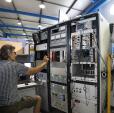
Showing 2261 - 2280 of 2826 results
DGet! An open source deuteration calculator for mass spectrometry data
Dr Kirrily Rule elected onto Australian Institute of Physics executive committee
Success in clinical trials
Shift in the treatment of blood cancers taking place.
Innovation Precinct highlighted in South District Plan
ANSTO’s Innovation Precinct has been highlighted in the Greater Sydney Commission’s South District Plan.
QUOKKA Celebrates front cover
Journal of Applied Crystallography features QUOKKA

Travel Funding
The Australian Synchrotron provides funding support for successful beamtime applicants in the form of travel funding and/or onsite accommodation. Travel funds granted are to be used solely to cover the majority of the cost to travel to the AS facility. The User Office will book accommodation for interstate user groups at the onsite AS Guesthouse.
Scientist awarded for work probing nanoscale magnetic structures in thin films using neutron scattering
Nuclear techniques help unlock structure
Research on a rare type of superconducting intermetallic alloy
Fossilised teeth tell the story of feeding habits of extinct reptiles, including dinosaurs

PDViPeR
A data manipulation tool for the Powder Diffraction beamline.
Project milestone reached
The concrete plinth for the new SPATZ neutron reflectometer has been delivered.
Work on Spin Nematics published in Phys. Rev. Letters
Bilby study on lecithin
First paper from Bilby investigates the effects of inorganic ions on the self-assembly of lecithin

Radiation Testing - Facilities Technical Specifications
ANSTO provides multiple sources for radiation testing of materials and devices including Co-60 gamma sources, x-ray, proton and heavier ion-beams.

Nuclear Reaction Analysis
Nuclear Reaction Analysis (NRA) detects charged particles and is used predominantly to determine concentrations and depth profiles of the lighter elements.
First user experiment on Taipan Beryllium-Filter Spectrometer
Work on Coordination Frameworks in Nature Chemistry

Micro-Particle Induced X-ray Emission
Micro-Particle Induced X-ray Emission (µPIXE) is used to construct elemental maps that show variations of an element's concentration across the sample surface.
Going underground to understand Australia's past climate variability
Given the importance of water in Australia, surprisingly, there is relatively little information about the past variability of rainfall on this continent. Although there is a good annual record of the past 100 years in Australia, there is nothing much before that period and no known cave deposit records exist for New South Wales.